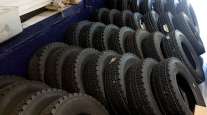Dealers, Fleets Increase Use of Scrap Analysis to Extend Life of Tires, Cut Costs for Carriers
This story appears in the Feb. 25 print edition of Transport Topics.
Every month or so, Dustin Stricker, the maintenance manager at R.E. West Transportation in Ashland City, Tenn., sits down with representatives from South Carolina-based Michelin North America and the local Tire Centers in Nashville to do autopsies on truck tires.
Not unlike the way actors on the popular television series, “CSI,” probe crime scenes for evidence of murder, Stricker said his team of experts is looking for telltale signs of tire abuse and neglect, structural defects and other factors to determine why a tire is worn out or otherwise unsuitable for retreading.
Industry officials call the process “scrap pile analysis,” and it is part of a growing trend of fleet operators and tire dealers working together to track tire use and to develop programs to extend tire life and minimize expenses associated with tire-related breakdowns.
Tire manufacturers, dealers and fleets who participate in such programs say the data analysis is useful not only to pinpoint causes of tire failures, but to also point the way to remedies, which can range from more aggressively monitoring tire pressure to buying different kinds of tires for various freight-hauling applications.
“The amount of data that you can get now is incredible,” said Keith Iwinski, distribution channel manager for Bridgestone Commercial Solutions Group, a unit of Bridgestone Americas, based in Nashville, Tenn. “It’s a matter of dissecting the data. In general, fleets rely heavily on what our dealers can provide.”
Bridgestone’s dealers collect data on tires from more than 1,000 fleet customers, Iwinski said.
Rick Phillips, director of commercial sales for Yokohoma Tire Corp., which is headquartered in Fullerton, Calif., said many of its independent dealers routinely do yard checks at a customer’s location, checking air pressure and performing preventative tire maintenance.
At Continental Tire the Americas, Fort Mill, S.C., technicians use a handheld wireless device to record information about a fleet and then report key performance indicators to fleet operators.
In 2012, Continental representatives used the ContiTrack2 system to complete 349 fleet checks for 29,177 tires, said Kevin Naumann, program manager.
Using projected mileage and cost-per-mile data, Naumann said, the system can generate reports showing losses due to improper air inflation and improper tire matching, estimate the dollar value of tires in the fleet based on tread depths and tire types, forecast projections of upcoming tire needs, and spotlight conditions that require immediate action by the fleet.
Goodyear Tire & Rubber Co., based in Akron, Ohio, offers a comprehensive program called Fleet HQ to track tire use and control expenses through its company-owned Wingfoot Commercial Tire Systems business unit and a network of independent tire dealers.
Fleet HQ offers scrap tire analysis and emergency roadside assistance, monitors the service history of individual tires with a computer program called Tire Trac and provides fleet operators with an electronic “dashboard” that shows the condition and performance of tires in the field.
Wingfoot president Paul Wanstreet said the availability of timely reports on the condition of tires enables truck operators to make more informed decisions about when to replace or retread tires. The data also gives fleets information they can use to change the way they maintain tires, which can extend tire life and improve fuel economy.
Another feature of Fleet HQ is a trailer-readiness program to help fleets keep equipment in compliance with federal safety regulations.
The Federal Motor Carrier Safety Administration’s Compliance, Safety, Accountability program is forcing truck drivers to be more diligent about checking tire pressure during pre-trip and post-trip inspections to avoid getting flagged during roadside inspections, Goodyear officials said.
Jeff Lecklider, president of Gem City Tire in Dayton, Ohio, said his business is changing in response to the increase in interest by fleets in protecting tires. Gem City operates six tire service shops in four states and a retreading plant.
“We don’t want to be just a tire provider,” Lecklider said. “If you want a deal on six tires, we might not be your guy.”
The company currently is tracking about 15,000 tires for about 240 customers.
“My job is to do whatever I can to help drive costs out,” Lecklider said. “In truth, it’s not that difficult to do. Tires are more expensive. A lot of fleets are looking for help.”
“Business models are changing,” said Scott Bennett, vice president of sales for Service Tire Truck Centers, Bethlehem, Pa., an independent tire dealer with 41 locations in eight states from New Hampshire to Virginia.
“In the 1980s and 1990s, our service trucks waited for the telephone to ring and then we would chase down trucks. Now, 60% to 70% of trucks go to a customer’s facility where we can install, inflate and fix tires on-site. This has been a megatrend for the last five to seven years and it continues to ramp up,” Bennett said.
The adoption of tire pressure monitoring systems and the increase in preventative maintenance is also contributing to fewer tire-related breakdowns on the highway.
Bennett said the number of emergency tire road calls in December and January this year were down 13% compared with the same period a year ago.
Tire dealers say that many fleet operators began seriously looking for ways to extend the life of their tires during the economic downturn in 2010 and 2011 because commercial tires were in short supply.
“We were able to talk to customers about tire longevity,” Bennett said. “Fleets are now getting more mileage from their tread. And when you buy a premium tire, you expect it to be retreaded several times. We’ve been able to extend at least one additional retread without jeopardizing safety, depending upon the tire application.”
The efforts of truck operators to extend the life of tires appear to be paying off. A survey of operating costs of trucking by the American Transportation Research Institute published in 2011 showed average marginal costs of tires falling from 3 cents per mile in 2008 to 2.6 cents in 2010, a drop of 13% at a time when overall trucking costs declined by only 9.8%.
Among the changes implemented at R.E. West Transportation, according to Stricker, was the adoption of an air pressure monitoring system that alerts drivers any time air pressure falls by more than 10 pounds per square inch and the conversion of nearly all of the company’s 130 heavy-duty tractors to wide-based single tires.
As a result of the changes, tires are now getting about 16,000 miles per 1/32-inch tread wear, compared with between 13,000 and 14,000. And some trucks are getting close to 8 miles per gallon fuel economy, Stricker said.
By keeping tires in service longer and retreading more tires, Stricker said the company is saving money by buying fewer new tires.
“We’re seeing our investment in tires stretched out,” Stricker said.
The trend of fleets buying fewer new tires could also trigger changes in some tire dealer operations.
At Service Tire Truck Centers, for instance, the company has added truck maintenance and repair services under the moniker Service Tech at 10 of its tire service locations.
“We need to be more than just a tire dealer,” said STTC’s Bennett. “There will always be a limited number of tire replacements. We are moving to mechanical solutions where we do everything except warranty work. We are also growing the earthmover and mining business.”




